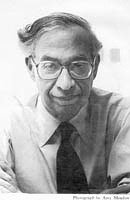
Donald Allen Wollheim was an American science fiction editor, publisher, writer, and fan. As an author, he published under his own name as well as under pseudonyms, including David Grinnell, Martin Pearson, and Darrell G. Raynor.

Philip Kindred Dick, often referred to by his initials PKD, was an American science fiction writer. He wrote 44 novels and about 121 short stories, most of which appeared in science fiction magazines during his lifetime. His fiction explored varied philosophical and social questions such as the nature of reality, perception, human nature, and identity, and commonly featured characters struggling against elements such as alternate realities, illusory environments, monopolistic corporations, drug abuse, authoritarian governments, and altered states of consciousness.

Do Androids Dream of Electric Sheep? is a dystopian science fiction novel by American writer Philip K. Dick, first published in 1968. The novel is set in a post-apocalyptic San Francisco, where Earth's life has been greatly damaged by a nuclear global war, leaving most animal species endangered or extinct. The main plot follows Rick Deckard, a bounty hunter who has to "retire" six escaped Nexus-6 model androids, while a secondary plot follows John Isidore, a man of sub-par IQ who aids the fugitive androids.
"Second Variety" is a science fiction novelette by American writer Philip K. Dick, first published in Space Science Fiction magazine, in May 1953. Set in a world where war between the Soviet Union and United Nations has reduced most of the world to a barren wasteland, the story concerns the discovery, by the few remaining soldiers left, that self-replicating robots originally built to assassinate Soviet agents have gained sentience and are now plotting against both sides. It is one of many stories by Dick to examine the implications of nuclear war, particularly after it has destroyed much or all of the planet.
"We Can Remember It for You Wholesale" is a science fiction novelette by American writer Philip K. Dick, first published in The Magazine of Fantasy & Science Fiction in April 1966. It features a melding of reality, false memory, and real memory. The story was adapted into the 1990 film Total Recall with Arnold Schwarzenegger as the story's protagonist; that film was remade in 2012 with Colin Farrell as the protagonist.
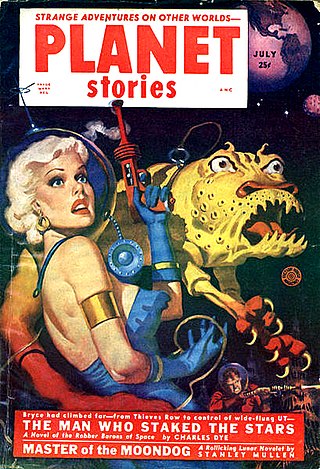
"Beyond Lies the Wub" is a science fiction short story by American writer Philip K. Dick. It was his first published genre story, originally appearing in Planet Stories in July 1952. It was first collected in The Preserving Machine in 1969, and was included in The Best of Philip K. Dick in 1977. It was the title story for the first volume of the original edition of Dick's collected stories. Translations of "Beyond Lies the Wub" have appeared in Dutch, French, German, Italian, Polish and Spanish; and the story has been included in more than a dozen anthologies.
"Sales Pitch" is a science fiction short story by American writer Philip K. Dick, first published in Future Science Fiction magazine, June 1954. The premise is the omnipresent, intrusive and even aggressive advertising and marketing. At the end of the story, the protagonist is driven mad by a robot who can forcefully market himself, and refuses to take no for an answer. The subject was of concern to Dick, and features in his early works such as The Man Who Japed.

"Upon the Dull Earth" is a fantasy short story by American writer Philip K. Dick, first published in November 1954 in Beyond Fantasy Fiction.
"The Electric Ant" is a science fiction short story by American writer Philip K. Dick. It was first published in Fantasy and Science Fiction magazine in October 1969.
"Roog" is a science fiction short story by American writer Philip K. Dick. It was his first sold work, although not his first published story.

Solar Lottery is a 1955 science fiction novel by American writer Philip K. Dick. It was his first published novel and contains many of the themes present in his later work. It was also published in altered form in the UK as World of Chance. The main story is about a man named Ted Benteley who lives in a strange world, dominated by percentages and the lottery. Lotteries are used to choose the next leader as well as a new assassin, whose job is to try to kill the leader or "Quizmaster". Everybody in society has the opportunity to be selected as a leader or an assassin. Benteley unexpectedly gets chosen to be a member of the committee trying to assassinate the new Quizmaster and he must decide what he is going to do.
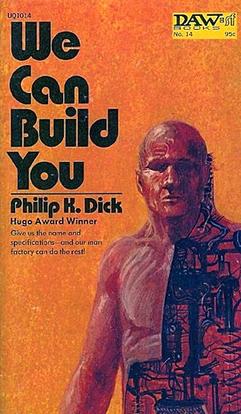
We Can Build You is a 1972 science fiction novel by American writer Philip K. Dick. Written in 1962 as The First in Our Family, it remained unpublished until appearing in serial form as A. Lincoln, Simulacrum in the November 1969 and January 1970 issues of Amazing Stories magazine, re-titled by editor Ted White. The novel was issued as a mass market paperback original by DAW Books in 1972, its final title provided by publisher Donald A. Wollheim. Its first hardcover edition was published in Italy in 1976, and Vintage issued a trade paperback in 1994.
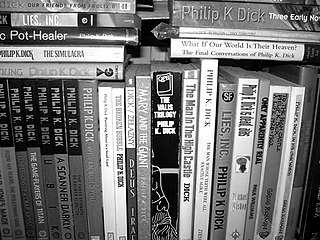
The bibliography of Philip K. Dick includes 44 novels, 121 short stories, and 14 short story collections published by American science fiction author Philip K. Dick during his lifetime.

Alternate Realities is a 2000 omnibus collection of three short science fiction novels by American writer author C. J. Cherryh: Wave Without a Shore (1981), Port Eternity (1982), and Voyager in Night (1984). All three novels are set in Cherryh's Alliance-Union universe and share a common theme of people encountering and coping with a reality different from their own.
Pilgrim on the Hill was a lost, early, non-science fiction novel by Philip K. Dick. It was written somewhere around 1956 according to one account, or between 1948 and 1950 according to another account. According to Lawrence Sutin's book, Divine Invasions: A Life of Philip K. Dick, the plot survives only as an index card synopsis from the publisher dated 11/08/1956 as follows:
Nicholas and the Higs is one of several early, unpublished novels by American science fiction author Philip K. Dick. It was written somewhere around 1957 during the waning days of his second marriage, was re-written at the behest of his publisher in 1958, and was then ultimately rejected for publication. The original manuscripts have been lost, and no copies are known to be extant.
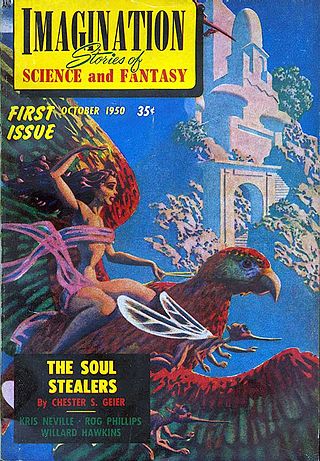
Imagination was an American fantasy and science fiction magazine first published in October 1950 by Raymond Palmer's Clark Publishing Company. The magazine was sold almost immediately to Greenleaf Publishing Company, owned by William Hamling, who published and edited it from the third issue, February 1951, for the rest of the magazine's life. Hamling launched a sister magazine, Imaginative Tales, in 1954; both ceased publication at the end of 1958 in the aftermath of major changes in US magazine distribution due to the liquidation of American News Company.
"Meddler" is a science fiction short story by American writer Philip K. Dick. It was first published in Future Science Fiction, October 1954 with illustration by Virgil Finlay. Dick had submitted many short stories to magazines and made approximately fifteen sales before becoming a client of the Scott Meredith Literary Agency. This was his second SMLA submission, received by SMLA on July 24, 1952. His first SMLA submission was The Builder, received by SMLA on July 23, 1952.











